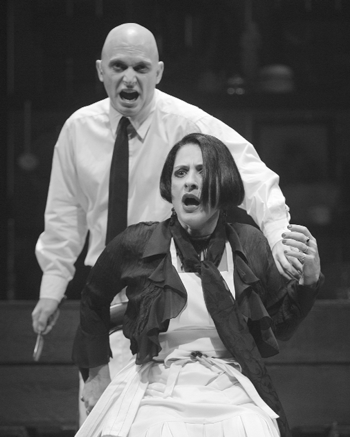John Doyle’s darkly disturbing “Sweeney Todd”
Rejoice! “Sweeney Todd” is back on Broadway in a production that is pure genius. Rich in storytelling, gripping in intellectual scope, and performed by a superlative cast, this quintessential 20th century musical, with book by Hugh Wheeler and music and lyrics by Stephen Sondheim, has been reconceived for today’s world. Intimate, gripping, and more darkly disturbing than previous productions, it is political theater of the first order in the guise of a seat-edge storytelling experience.
Director John Doyle’s pared down production, which originally appeared in London last year, may have been dictated by a lack of finances, but he has more than compensated with dazzling ideas and flawless staging. Elementally human in its insistence upon the power of story and character as the prime motivators of theater, the lead roles have never been so fully explored, so provocatively rendered.
The original Harold Prince production portrayed Sweeney as a man crushed by the advancing industrial age and the careless destruction of the individual soul—the inevitable cost of creeping mechanization. It was epic in its scope and a profound piece of social commentary consistent with the 19th century Grand Guignol tales of the original source material—a penny dreadful designed to shock and divert. Immediate and raw, Doyle’s Sweeney is a study in revenge and passion—personal, rage-filled, and the inevitable response of a man who has had his power and humanity systematically and willfully stripped away by his enemy. Performed with brilliance by Michael Cerveris, this is a Sweeney in response to the corruption of our time—a man crushed because he got in the way of a powerful man’s ego. The staggering selfishness, cynicism, and amorality of Judge Turpin, who commutes Sweeney to Australia in order to snatch Sweeney’s wife, takes on eerie echoes of a culture where people in the way of those in power are marginalized, vilified, and ruined. It is a familiar evil, and Doyle never shies away—or pulls his punches.
This is evident in the physical production, which Doyle also designed. Whereas Prince’s set was a huge machine that dwarfed the cast, Doyle has set his production in a spare asylum that has a coffin at its center. Dominating the set is a tower of household objects—soup tureens, religious icons, the litter of every day life. This is a world dominated by material possessions, by people whose greed has fomented the corrosion of their values. This tower of stuff torments Sweeney and Mrs. Lovett. It is the life they see around them, but from which they are barred due to class and circumstance. The desperate times that provoke Sweeney’s desperate actions are insidious, blind, and all-too-common
But this is not just the story of Sweeney Todd’s revenge. His accomplice, Mrs. Lovett, the woman who first hatches the cannibalistic plot and who actually goads Sweeney to turn his plotted revenge against one man to profitable employment, is a portrait of the opportunist we see all too often in our world. Sacrificing lives in Iraq or defrauding shareholders is really not that much different than baking murder victims into pies—as long as one can make a convincing case for it.
The reason the horror works to such a ferocious level in this production is partly Doyle’s vision, but for the audience it is also the cathartic release inherent in telling the truth about what drives people. Doyle begins his production with the character Tobias straitjacketed and gagged; the only voice of truth has been forcibly silenced by the powers that be. It is also a cautionary tale, as the cast stands downstage at the end of the show in the chilling finale, asking, “Isn’t that Sweeney there beside you?” noting of revenge that “everyone does it, but few do as well” as Sweeney.
Cerveris as Sweeney Todd is exceptional. His voice, acting, and star quality have never been better. He delivers a performance of such controlled fury that when he finally kills the judge, his release is palpable—and perversely sexual. This is an historic performance by a man in full command of his craft.
Patti LuPone as Mrs. Lovett gives the most chilling and fully rounded performance of her illustrious career; it resonates with the full humanity of this sick and desperate woman. Louche and amoral, flirtatious and terrifying, whether playing the tuba or trying to control events, LuPone is perfect. Her Mrs. Lovett is a woman on the brink, who gets only a taste of salvation before she is destroyed. In the original Prince production, the song “By the Sea” performed by Angela Lansbury provided comic relief. LuPone performs it as an act of desperation, a prayer against inevitable doom. By never lightening the tension she brilliantly takes us deeper into the unmitigated cynicism of the character. Similarly, “A Little Priest,” the song that ends the first act, as performed by Ceveris and LuPone, is not merely a clever set piece that makes light of murder and cannibalism, but an inside look at how corruption can fester.
The rest of the cast is equally wonderful. They are onstage throughout, fluidly moving between playing instruments and playing their roles. The richness of the sound and the accomplishment of the singing are remarkable for the chamber-sized production that fills the Eugene O’Neill. Diana DiMarzio as the beggar woman, Michael Felicano as Tobias, and Lauren Molina as Johanna are wonderful, and the company that includes Mark Jacoby, Benjamin Magnuson, Alexander Gemignani, Donna Lynne Champlin, and John Arbo is easily the best on Broadway right now—a perfect ensemble.
There are so many breathtaking details, so much intelligence and so much rich storytelling going on in this production that describing them is insufficient. They must be experienced. If you love theater, and are willing to face your darkest demons, don’t miss this superior production of a theater classic.
gaycitynews.com



































